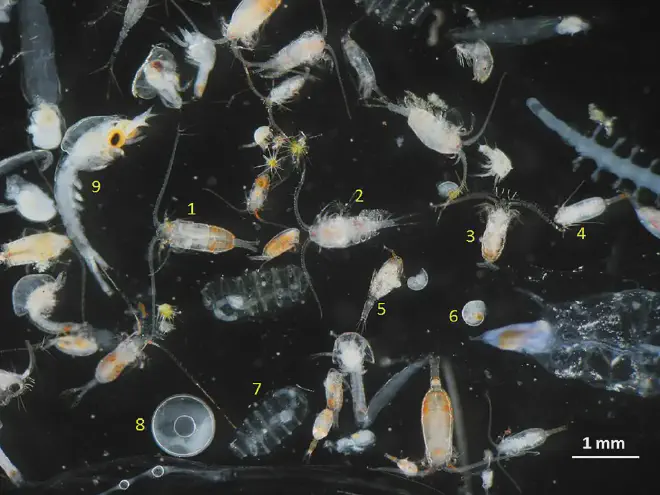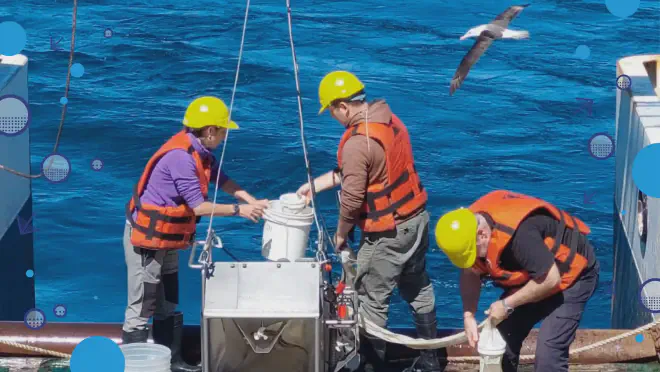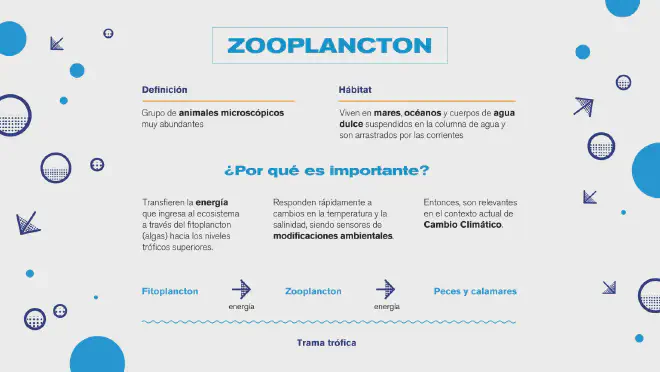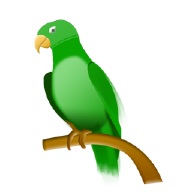
Georgina Cepeda is a researcher at CONICET in the Institute of Marine and Coastal Research (IIMYC, CONICET-UNMDP) and studies the zooplankton of the Argentine Sea and its surroundings, specifically the variations that this group of microscopic animals presents in time and space and their relationship with environmental variables. “Studying this group provides crucial information about marine ecosystems, for example, about the quantity, type, and location of food available for higher trophic levels, which feed on zooplankton, including many fishery resources,” she explained.

Zooplankton #
Zooplankton is a very abundant and diverse group of animals that inhabit seas, oceans, and also freshwater. They come in various sizes, although most range from a few millimeters to a few centimeters. They live suspended in the water column and are carried by the water masses without offering much resistance. They have the particularity of transferring the energy that enters the ecosystem through phytoplankton, that is, algae, to the higher trophic levels, many of which are commercially important such as some fish and squids.

Besides being the basis of the trophic plot, these organisms respond relatively quickly to changes in environmental conditions, such as temperature and salinity, among others. And in a context of climate change, like the current one, where many areas of the oceans experience temperature variations, it is very likely that changes will also occur in zooplankton, which may then influence higher trophic levels or the trophic web in general.
Been onboard… that experience #
Part of Cepeda’s work takes place in the laboratory and also in scientific research campaigns at sea. When she embarks, collect samples with nets specifically designed to ‘catch’ zooplankton at different geographical points of interest, depending on the ecosystem they are verifying, which are then analyzed with a magnifying glass and microscope to determine what species were found, in what quantity, and where. The data obtained responds to the specific objectives of each campaign, which are often conducted to assess the status of the fishery resources of the Mar Argentino.

“I also take samples during campaigns with strictly environmental purposes in which information is gathered on many other variables, for example: oxygen, nutrients, chlorophyll, and bacteria. The analysis of all those variables together with the zooplankton allows us to understand the health of each ecosystem,” said Cepeda. The campaigns frequency, both fishing and environmental, allows to have a large volume of data that enables researchers to detect whether there have been or are variations over time in the different studied ecosystems, in the composition, distribution, and abundance of zooplankton. In the event of modifications, this analyzed data together is essential to understand why such changes occur and what implications they may have on the marine trophic web.
Why Biology? #
“Since I was little - Cepeda remembers - I always had a very particular interest in nature, and my parents always encouraged it. I remember waiting with a dictionary in hand for my dad to come home from work to look at the ’little drawings’ of animals and plants that caught my attention. My grandparents had a garden at their house, and I was always there when we go to visit them.” But it was through a family friend who is a biologist, Susana Bo, who showed her the profession back in the last years of elementary school. “I remember helping her look at some samples she brought from her campaigns to Antarctica, accompanying her to the faculty’s laboratory where I would later return, but as a student. Even in high school, I realized that this was a job, and I didn’t hesitate; I knew what I wanted to dedicate myself to. Perhaps I wasn’t clear on what I would specialize in or where I would end up, but I knew I wanted to be a biologist.”
Several years later, as an advanced student in the Biology program, she began conducting research internships at the Zooplankton Laboratory at the National Institute of Fisheries Research and Development (INIDEP), where she currently continues to work. “Not being too sure if plankton was really what I liked the most, I started with that and basically never left. At INIDEP, I was lucky to meet several researchers who helped guide my path, from whom I learned and continue to learn a lot constantly. I also had the opportunity to work with several researchers from abroad who welcomed me wonderfully in their laboratories; all of them were and are extremely important people who help me navigate this path of being a biologist and now a researcher.”
The zooplankton specialist reflects on vocation and the definition of a university career. She pointed out that, as in her case, there are people who have a very marked and defined vocation, which is not always the case, and there are many others who do not find their vocation so quickly and explore various careers in search of the definitive one. “Also, it is very good and one must be motivated because by trying, one might find their true vocation or eliminate options until they discover what is really meant for them. On one hand or the other, whether it is in the field of Biology or any other, I believe the message should be to encourage oneself and start studying; once the path is begun, one can see, but one must start and not be afraid of making mistakes,” she concluded.
Important #
-
The article “Vocación por el mar,” signed by Sabrina Aguilera from the CCT Mar del Plata Communication Area, can be read here.
-
The advance of “Miradas de Ciencia” #3 – Océano” can be downloaded here.
Oceans Day #
English Abstract #
Georgina Cepeda is a researcher at CONICET in the Instituto de Investigaciones Marinas y Costeras (IIMYC, CONICET-UNMDP). She focuses on studying the zooplankton of the Mar Argentino and adjacent areas, specifically analyzing the variations in time and space of these microscopic animals and their relationship with environmental variables. By studying this group, valuable information about marine ecosystems is gathered, such as the quantity, type, and location of available food for higher trophic levels that feed on zooplankton, including many important fishery resources.
What is Zooplankton?
Zooplankton is a highly abundant and diverse group of animals found in seas, oceans, and freshwater bodies. They come in various sizes, ranging from a few millimeters to a few centimeters. They live suspended in the water column, drifting along with water masses. Zooplankton play a crucial role in transferring energy from phytoplankton (algae) to higher trophic levels, many of which are commercially important species like fish and squids.
These organisms are not only the foundation of the food web but also exhibit relatively rapid responses to environmental changes, such as temperature and salinity. In the current scenario of climate change where many oceanic regions are experiencing temperature variations, changes in zooplankton are likely to occur, ultimately impacting higher trophic levels and the overall food web.
Her Field Experience
Georgina Cepeda’s work involves both laboratory research and scientific expeditions at sea. During these expeditions, she collects samples using specialized nets designed to capture zooplankton at various geographical points of interest. These samples are later analyzed under a microscope to identify species, quantities, and distribution. The data obtained serve the specific objectives of each expedition, often aimed at assessing the state of fishery resources in the Argentine Sea.
In addition to fishery-focused expeditions, Cepeda also participates in environmental research campaigns to gather information on various variables like oxygen, nutrients, chlorophyll, and bacteria. Analyzing these variables alongside zooplankton data provides insights into the health of each ecosystem. The regularity of these campaigns, whether for fisheries or environmental purposes, generates a vast amount of data that helps detect changes over time in the composition, distribution, and abundance of zooplankton within the studied ecosystems.
Oceans Day #
English Abstract #
Georgina Cepeda is a researcher at CONICET in the Instituto de Investigaciones Marinas y Costeras (IIMYC, CONICET-UNMDP). She focuses on studying the zooplankton of the Mar Argentino and adjacent areas, specifically analyzing the variations in time and space of these microscopic animals and their relationship with environmental variables. By studying this group, valuable information about marine ecosystems is gathered, such as the quantity, type, and location of available food for higher trophic levels that feed on zooplankton, including many important fishery resources.
What is Zooplankton?
Zooplankton is a highly abundant and diverse group of animals found in seas, oceans, and freshwater bodies. They come in various sizes, ranging from a few millimeters to a few centimeters. They live suspended in the water column, drifting along with water masses. Zooplankton play a crucial role in transferring energy from phytoplankton (algae) to higher trophic levels, many of which are commercially important species like fish and squids.
These organisms are not only the foundation of the food web but also exhibit relatively rapid responses to environmental changes, such as temperature and salinity. In the current scenario of climate change where many oceanic regions are experiencing temperature variations, changes in zooplankton are likely to occur, ultimately impacting higher trophic levels and the overall food web.
Her Field Experience
Georgina Cepeda’s work involves both laboratory research and scientific expeditions at sea. During these expeditions, she collects samples using specialized nets designed to capture zooplankton at various geographical points of interest. These samples are later analyzed under a microscope to identify species, quantities, and distribution. The data obtained serve the specific objectives of each expedition, often aimed at assessing the state of fishery resources in the Argentine Sea.
In addition to fishery-focused expeditions, Cepeda also participates in environmental research campaigns to gather information on various variables like oxygen, nutrients, chlorophyll, and bacteria. Analyzing these variables alongside zooplankton data provides insights into the health of each ecosystem. The regularity of these campaigns, whether for fisheries or environmental purposes, generates a vast amount of data that helps detect changes over time in the composition, distribution, and abundance of zooplankton within the studied ecosystems.

